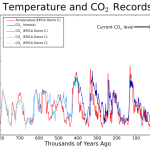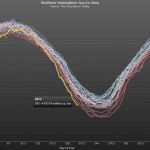ice sheets
A commenter on the most recent edition of het's AWOGWN asks an interesting set of questions:
How would temperature data have been seen during the last 10,000 years prior to the peak of each of the previous Milankovich cycles? What caused the temperature to reverse course in those cycles and why would we not expect it to occur again this time?
First, here are the quick answers to those three questions, then some discussion. 1. It is not currently possible to resolve the temperature record that long ago to anything close to what we have today. 2. The cause of the temperature…
Some interesting goings-on in the cryosphere these days.
In this chart (click the link for an interactive, larger resolution version) from the cryosphere today we can see that we are on the 45th day in a row of daily record lows in sea ice area.
Note that this is area which is different from extent. Area refers to the actual ice cover, I am not sure of the details of how that is defined in practice, whereas extent refers to any ocean surface that contains 15% or more ice cover. Again, there will be technical details I am not familiar with for determining the edges of extent (e.g.…
Thingsbreak has a great overview of recent research on ice loss in the Antarctic (east and west) and Greenland.
For anyone who has had enough of the freedom vs responsibility of the press discussion (mandas?), perhaps there are some interesting bits in Thingsbreak's post to mull over.
I have posted on sea ice dynamics before (here), the two topics are not unrelated as stable ice shelves act as resistors to out flowing glaciers. Lost sea ice leads to faster glacial outflow which leads to thining ice sheets.
[Update: I have just observed out my window that it is snowing, I imagine this can…
I found this from a comment on a Skeptical Science article (worth a read in its own right) and thought readers here might be impressed.
It is from a TED talk by James Balog who has been creating fascinating and awe inspiring time-lapse videos of calving glaciers. The whole talk is about 20 minutes and worth listening to, if you must you can jump ahead to around the 9th minute when the set-up ends and the visuals begin:
Of course, the whole thing could have been cooked up by Phil Jones and CRU, with help from the NASA moon-landing fakers...

